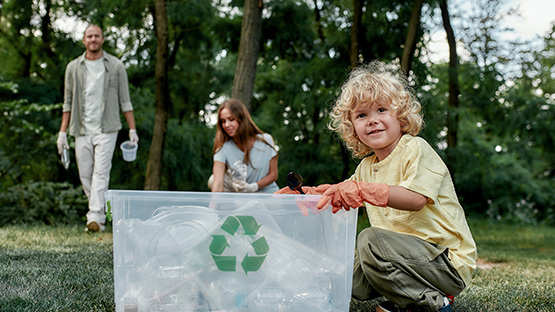Global warming - effects and causes
Ekologia

13 January 2023
Human activity is the main cause of global warming. Before the industrial era, the global temperature was 1 degree lower than today. What influences global warming and what are the consequences of its behaviour?
Global warming - the effects of human activity
Global warming is a problem the whole world is currently facing. First and foremost, it has to do with the increase in CO2 concentration, which has consequently caused the average global temperature to rise by an average of 1°C over the past industrial era. Many people wonder why there is global warming?
What has influenced global warming? The first association that comes to mind is man. It is through his actions following the industrial age that global climate change has occurred. The development of industry, transport, but also agriculture has also had a big impact. There are many reasons for this phenomenon, but not everyone is aware of the serious consequences that are associated with climate change.
How does global warming affect the climate?
How does global warming affect the climate and what does it cause? These include negative effects such as melting glaciers, increasing water levels, the occurrence of dangerous atmospheric phenomena such as tornadoes, windstorms and floods. The consequences that result from global warming also include anomalies in the flow of circulating water, a protracted growing season for greenery, a greater risk of fires, and the displacement of flora and fauna, which consequently contributes to the transfer of insects and pests that cause, among other things, infectious diseases.
What is the effect of global warming on the earth?
The effects of increased temperatures in the future will have a negative impact on the entire ecosystem. The process of rising temperatures is being tracked by scientists all the time. As a result, they are also able to calculate the risks and dangers that may occur due to global warming. Changes that will result from global warming, according to experts, include evaporation of water, droughts, as well as the extinction of 18% of plant species and 35% of animal species by 2050. 
How to counter the effects of global warming?
Educating ourselves about global warming is essential in order to realise how serious the problem is, as well as how to counteract undesirable environmental changes. The most important factor that causes global warming to occur on the earth's surface is the spread of CO2 emissions. Therefore, in order to counteract this climate change, it is important to focus on reducing carbon emissions. Many companies are trying to make a positive impact on the planet and reduce the release of harmful substances into the atmosphere.
One such company is InPost, which has long been at the forefront of eco-solutions thanks to its modern applications. InPost is a company which delivers parcels both directly to the consumer's door and to a Paczkomat® machine. Thanks to its patented parcel delivery method, CO2 emissions are reduced. In addition, InPost boasts an electric fleet of cars which it uses to deliver parcels, which also contributes to lower carbon dioxide emissions.
What can be done to reduce carbon emissions? First and foremost, small changes need to be made which, if applied consistently, can have a positive impact on the environment and cleaner air. First and foremost these are:
- Putting only lukewarm or completely cooled food in the fridge,
- Turning off the light when no longer in use,
- Reducing water consumption,
- Use of reusable bags,
- Restriction of document printing,
- Using environmentally friendly means of transport, such as bicycles.
What naturally absorbs CO2?
Although the oceans generate gigantic amounts of carbon dioxide, it is important to remember that they are also capable of absorbing it. At the moment, the oceans absorb more CO2 than they produce. As a result, they reduce man-made emissions by as much as half. The ocean owes its function of cleaning the air of harmful substances to plankton, such as algae or certain bacteria that have the ability to photosynthesise. There are also plants planted in the soil that can absorb smog emitted into the atmosphere. These include chrysanthemums, dracaenas, common ivies, Benjamin's ficus, and ferns. There are also trees that are worth planting to offset CO2, these are: oaks, acacia robins, and beech. As it turns out, peat bogs and marshes can also contribute to cleaning harmful substances from the air.
How do you reduce CO2 in a room?
Indoor air monitoring, especially for public use, is extremely important. This is because it affects the health of the people who live there on a daily basis. The air in the workplace or home is just as important as the air outside.
To reduce the carbon dioxide in your four walls, remember to ventilate your room regularly. Proper circulation is the key to cleaner air. A good idea that many companies use in rooms to reduce carbon dioxide is also to put plants in pots, which naturally absorb CO2 and release oxygen.
Are the effects of global warming reversible?
Scientists who have been appointed to the institution's climate change panel are sounding the alarm that if temperatures rise above the 1.5 degree ceiling, the effects of global warming may probably no longer be reversible. The more man interferes with the environment, the more severe the effects on humanity are likely to be.
The way to reverse current climate change is to change energy policies in countries. Experts recommend implementing renewable energy sources such as those derived from: air, water and also the sun. Despite the negative prognosis of climate warming by experts, it is possible to have a real impact on the intensity of the release of harmful substances into the atmosphere. To this end, every inhabitant of the earth should start with small changes in his or her environment, which will ultimately have the desired effect of saving the planet from a climate catastrophe.
Czytaj również

Where to donate your clothes? Give them a second life together with InPost!
Where to donate clothes you no longer wear? Instead of throwing away good clothes, it is worth donating them to others for further use. Do...

Where to give away unwanted electronic equipment? Small items can still be useful
Electronic equipment is one of the most frequently replaced items in the home. New ones are not always bought when the old ones are no lon...

Where to donate toys you no longer need? We have a good way to do it!
Quite a few children have rooms full of toys. They receive more gadgets from grandparents, parents or aunts and uncles. Sometimes the obje...



